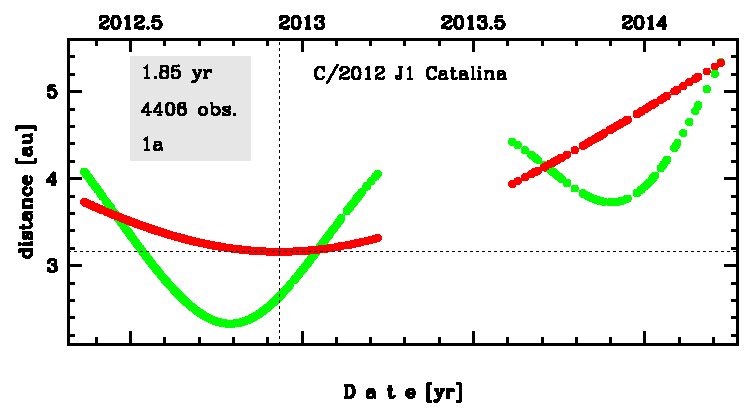C/2012 J1 Catalina
more info
Comet C/2012 J1 was discovered on 13 May 2012 with Catalina Sky Survey, that is about 7 months before its perihelion passage. It was systematically observed less than 2 years, exept 5 months interval between 21 March and 12 August 2012.
Comet had its closest approach to the Earth on 15 October 2012 (2.332 au), five months after its discovery and less than two months before perihelion passage.
Solution given here is based on data spanning over 1.85 yr in a range of heliocentric distances: 3.73 au – 3.159 au (perihelion) – 5.33 au.
This comet have orignal semimajor axis shorter than 10,000 au.
C/2012 J1 suffers moderate planetary perturbations during its passage through the planetary system that lead to escape the comet from the planetary zone on a hyperbolic orbit (see future barycentric orbit).
Comet had its closest approach to the Earth on 15 October 2012 (2.332 au), five months after its discovery and less than two months before perihelion passage.
Solution given here is based on data spanning over 1.85 yr in a range of heliocentric distances: 3.73 au – 3.159 au (perihelion) – 5.33 au.
This comet have orignal semimajor axis shorter than 10,000 au.
C/2012 J1 suffers moderate planetary perturbations during its passage through the planetary system that lead to escape the comet from the planetary zone on a hyperbolic orbit (see future barycentric orbit).
| solution description | ||
|---|---|---|
| number of observations | 4406 | |
| data interval | 2012 05 13 – 2014 03 21 | |
| data type | perihelion within the observation arc (FULL) | |
| data arc selection | entire data set (STD) | |
| range of heliocentric distances | 3.73 au – 3.16 au (perihelion) – 5.33 au | |
| detectability of NG effects in the comet's motion | NG effects not determinable | |
| type of model of motion | GR - gravitational orbit | |
| data weighting | YES | |
| number of residuals | 8690 | |
| RMS [arcseconds] | 0.26 | |
| orbit quality class | 1a | |
| previous orbit statistics, both Galactic and stellar perturbations were taken into account | ||
|---|---|---|
| no. of returning VCs in the swarm | 5001 | * |
| no. of escaping VCs in the swarm | 0 | |
| no. of hyperbolas among escaping VCs in the swarm | 0 | |
| previous reciprocal semi-major axis [10-6 au-1] | 240.86 – 241.08 – 241.30 | |
| previous perihelion distance [au] | 3.15034 – 3.15035 – 3.15036 | |
| previous aphelion distance [103 au] | 8.2852 – 8.2928 – 8.3006 | |
| time interval to previous perihelion [Myr] | 0.2663 – 0.2667 – 0.2671 | |
| percentage of VCs with qprev < 10 | 100 | |
| previous_g orbit statistics, here only the Galactic tide has been included | ||
|---|---|---|
| no. of returning VCs in the swarm | 5001 | * |
| no. of escaping VCs in the swarm | 0 | |
| no. of hyperbolas among escaping VCs in the swarm | 0 | |
| previous reciprocal semi-major axis [10-6 au-1] | 240.85 – 241.08 – 241.30 | |
| previous perihelion distance [au] | 3.15058 – 3.15059 – 3.1506 | |
| previous aphelion distance [103 au] | 8.2853 – 8.2929 – 8.3006 | |
| time interval to previous perihelion [Myr] | 0.2663 – 0.2667 – 0.2671 | |
| percentage of VCs with qprev < 10 | 100 | |
